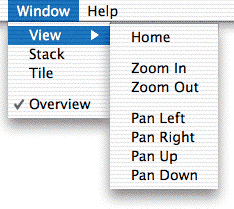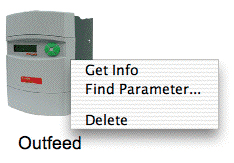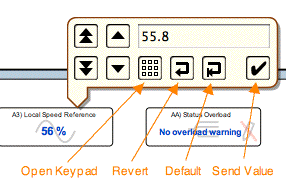Browser

The main windows of the application are similar to those in a web browser, with forward and back buttons. The application maintains a history of the pages that you visit and these buttons allow you to move forwards and backwards in this history. There is also an 'up' button which allows you to move to the logical parent of the current page (if any). If you hold down the control key (command/apple key on a Mac), you can use the arrow keys on your keyboard to move forwards, backwards and up.
Displayed pages may contain hyperlinks to other pages. The cursor changes to a finger pointer while over these hyperlinks, and clicking on one will display the new page. If you hold down the control key (command/apple key on a Mac) while clicking, the page will open in a new window; if you also hold down the shift key, the new window will be placed behind the current window.
Zoom and Pan

When first opened, a page is automatically zoomed and panned to fit completely in the current window size; this is called the 'home' view. You can always get back to the home view by selecting 'Home" from the 'View' submenu in the 'Window' menu. You can also zoom and pan from this menu.
Zooming can be done from the keyboard: zoom out by pressing the '-' key on the main keyboard or the numeric keypad, zoom in by pressing the '=' key on the main keyboard or the '+' key on the numeric keypad. You can also zoom centered on the current cursor position: zoom in by pressing the 'C' or 'F1' key, zoom out by pressing the 'X' key. The amount of zoom will be greater if you hold down the Alt key, and less if you hold down the Shift key.
Panning can be done from the keyboard in several ways:
- Use the numeric keypad to pan in eight directions; use the '5' key for home.
- use the arrow keys.
- use the A, S, W and D keys to pan in four directions (useful on a laptop).
- use the B, N, M, J, U. Y, T, G keys to pan in eight directions; use the 'H' key for home (also useful on a laptop).
The amount of pan will be greater if you hold down the Alt key, and less if you hold down the Shift key.
Live zooming can be done with the mouse: if you have a mousewheel, use it to zoom; or hold down the Alt and Control keys and drag the mouse horizontally (do not click). Live panning can be done with the mouse: if you have a middle button on your mouse, click and drag with it; or hold down the Alt key and drag the mouse (do not click). (Note that live zooming and panning are compute-intensive; if the page is complex and/or your computer is slow there may be a noticeable lag.)
There is also a preference to change the mousewheel function so that it pans instead of zooms. If this is enabled: the mousewheel pans vertically; if you hold down the shift key, it pans horizontally; and if you hold down the control (command/apple key on a Mac) key, it zooms.
Zooming can be done in two ways via a "marquee": shift-click and drag a marquee where you want to zoom - when the mouse button is released, the zoom will complete. Or shift-click once to start the marquee, move the mouse to define the marquee, and click again to complete the zoom (you can cancel the marquee by pressing the 'esc' key).
Finally, you can restore the home view from the keyboard by pressing the '5' key on the numeric keypad or the 'home' key or 'H' key on the main keyboard.
Multiple Windows
You may find it useful to have multiple windows open at the same time; this is particularly true if you are doing engineering work. You can switch between windows in the normal way or by selecting them by name from the 'Window' menu. You can also stack and tile them en masse from this menu. Note that if you close all the windows, the application will exit.
Multiple Users
The drive.web system is designed to support multiple simultaneous users. Changes made by one user are immediately visible to other users, and the software protects againsts collisions if more than one user attempts to change the same data item.
Note that, due to the architecture of the PL-series DC drives, changes made to GOTOs and GETFROMs are not immediately visible to other users. The software keeps these internal connections up-to-date by monitoring them, but it may take up to 30s (on a LAN, longer on a WAN) to detect an internal connection change made by another user (either at the keypad, via the serial port or via drive.web).
Active Objects

As noted above, pages may contain hyperlinks to other pages. In addition, a page may contain active objects such as devices or parameters. These active objects usually have a contextual menu associated with them which may be activated by right-clicking (or control-clicking on a Mac). The content of the contextual menu varies by both the type of active object and the current capability.
Active objects usually provide 'rollover' information at the top of the window, next to the back/up/forward buttons. This information varies by the type of the active object.

Some active objects e.g. parameters can have their value changed. Clicking on these objects presents a widget that allows the value to be changed; the widget is displayed at a fixed size (i.e. independent of the current zoom). This, along with the rollover information, allows pages to be used even when greatly zoomed out. The widget can be dismissed by either clicking outside the controls or pressing the 'esc' key.
Exiting
The application exits if (i) you choose Exit or Quit from a menu, or (ii) you close all the windows.
